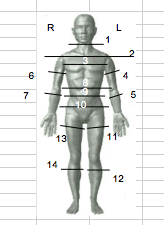We’ve talked about two types of measurements so far: mood/health and performance. Tied to that but something that is far more visible to everyone are measurements of body composition. It’s one thing to track something as subjective as how I feel each day of the experiment and trend that. It’s another thing to track overall performance over the experiment at regular intervals to see how my body is operating. However it is our body’s physical characteristics that are both the most visible and at the same time one of the important things that I want to track and trend over the experiment.
Most people familiar with dieting are familiar with part of this concept. People on diets track their weight and base their success on whether the scale is going down, staying flat or going up. Weight is an important thing to trend, but it is really just the tip of the iceberg. Over the course of a person starting to exercise and doing calorie restriction they can actually be losing fat as fast as they are gaining muscle, or nearly as fast, and thus not seeing how much fat they are losing. At the same time people who are staying sedentary and are in severe calorie restriction will show lots of weight loss but some of that will be muscle. There is also the entire issue that being thin doesn’t equate with being healthy.
I therefore want to extend beyond just weight. We can start by adding percent body fat to that equation. This allows us to track not just what we weigh but also what our composition is. I have a scale that can sense my percentage body fat. These scales abound, but their accuracy isn’t always that great. Being excessively hydrated, or dehydrated, having differences in salt consumption the day before et cetera can drive the measurements. The equations they use don’t exactly correlate well either. I know this because I got a skin fold measurement at the gym and took my measurement on the scale the same day. While it is off by several percentage points, it does tell me whether my body fat is trending up or down. Ideally your gym will be able to perform a skin fold check and they will do it by measuring skin pinches at 5-7 points on your body. My gym used to, but doesn’t any longer. I therefore am stuck with my benchmark from a year ago and then doing skin fold measurements on myself. There is a bit of art to the science however so I just track a pinch around my waist.
So far I’ve discussed measuring weight and percentage of body fat. However this really only tells part of the story still. Over time all dimensions of our body can change slightly due to how we are eating and how we are exercising. Many years ago (another blog article) I created a spreadsheet to start trending measurements all over my body. By measuring in all these areas I can see trends in things that just measuring weight or waist size can’t do. I can see whether I have asymmetry between the left and right half of my body. I can see whether my arms are getting smaller or bigger based on lack of exercise or because my diet is leading to them atrophying or enlarging. An area like my forearms or my calves will quickly show break down on a diet that isn’t giving my body the nutrients I need or if I’m engaging them in a way that is really working them hard and my body is a good state of nutrition.
The totality of my measurements can be visualized by the diagram (from my spreadsheet) with the corresponding measurements listed below:

- Neck
- Shoulders (with arms down)
- Chest (with arms down)
- Left bicep (flexed)
- Left forearm (flexed)
- Right bicep (flexed)
- Right forearm (flexed)
- Mid torso (narrow part below last rib)
- Upper waist (around belly button)
- Hips
- Left thigh (thickest point, flexed)
- Left calf (thickest point, flexed)
- Right thigh (thickest point, flexed)
- Right calf (thickest point, flexed)
- Body Weight
- Waist skin fold measurement
- Percent Body Fat
All of these measurements provide a very comprehensive picture of what my body is doing as it adjusts to lifestyle and diet. I’ve considered doing photographs as well. They actually have apps now that let you take a picture a day (or a week) and they will actually stitch them all together for you. It sounds pretty interesting in theory, and I’ve talked about the idea a bit before, but I’m not sure if I will get much out of it since I’m not targeting some drastic weight loss or muscle gain. I’m still kicking the idea around though.
Regardless of pictures being integral or not, trending these measurements (with years of measurements I already have) will allow me to directly measure if one of these eating styles is drastically changing my body composition or muscle mass.




 2013-10-22
in
2013-10-22
in

 4 min read
4 min read